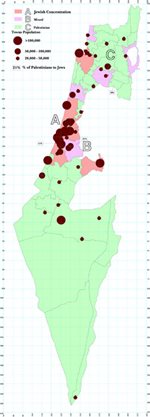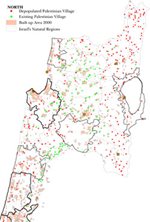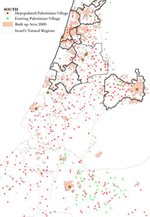 Fig-9: Population Distribution in Israel.
Fig-9: Population Distribution in Israel.
It is often claimed that there is no room in Israel for the refugees' return. Even if this were true, it would not diminish the fundamental right of return. In fact, this contention is false. Previous studies on the subject can be summarized as follows:
It is possible to divide Israel's forty-six natural regions into 3 groups [see Fig-9]:
Group-A, with an area of 1,628 square kilometres, has a Jewish population of just over 3 million (67 percent of Israel's total Jewish population). This area is, roughly, the land acquired by Jews during the period of the British Mandate. Most Jewish settlement after the creation of the state centred around this earlier domicile.
Group-B, 1,508 square kilometres in area, which is almost the same size but not the same location of the land owned by the Palestinians who remained in Israel after the 1948 war. (Since 1948, Israel has confiscated two-thirds of the property of its Palestinian citizens). In group-B, there are 436,000 Jews, or 9.6 percent of all the Jews in Israel, along with 92,000 of Israel's Palestinian citizens.
Thus, 77 percent of Jews live in 15 percent of Israel's area. That leaves group-C, which amounts to 17,381 square kilometres in area, located in two large blocks, corresponding roughly to the Northern and Southern Districts as per Palestine and Israel's administrative divisions. This is the land and heritage of about 5 million refugees who were expelled from their homes in 1948 and their descendants.
About one million Jews live in group-C, but 80 percent of them live either in cities that were originally Palestinian and are now mixed, or in a number of small new "development towns". These development towns, heavily populated by Sephardic Jews, or Mizrahi, (and more recently Russians) are generally impoverished, with the highest unemployment rates and the lowest annual incomes in Israel; they are living proof of the country's ethnic segregation and discriminatory policies.
 Fig-10: Built-up Area in Israel North (2000): The Location of the present built-up area shows that over 90% of the sites of Palestinian villages remain vacant.
Fig-10: Built-up Area in Israel North (2000): The Location of the present built-up area shows that over 90% of the sites of Palestinian villages remain vacant.
Thick black lines define high Jewish density 'natural regions'. Medium lines indicate medium Jewish density and light lines indicate low Jewish density.

Fig-11: Built-up Area in Israel South (2000): The Location of the present built-up area shows that over 90% of the sites of Palestinian villages are vacant.
The areas around Jerusalem and Tel Aviv require special treatment.
This leaves 200,000 rural Jews who exploit vast areas of refugee land (with the remainder of the land used for military purposes and afforestation). Most of these rural Jews (160,000) are residents of the moshavim (cooperative farms) and kibbutzim (collective farms). The kibbutz, which used to be the flagship of Zionism, is now dying out. Today only 8,600 kibbutzniks live on agriculture, assisted by tens of thousands of hired labourers from Thailand, an ironic subversion of Zionist doctrine, which prohibits the employment of non-Jewish (especially Palestinian) labour.
Thus, the rights of 5 million refugees are pitted against the prejudices of 8,600 kibbutzniks.
To illustrate the point further, consider this scenario: When the registered refugees in Lebanon (362,000) return to their homes in Galilee (still largely Arab) and the registered refugees in Gaza (759,000) return to their homes in the Southern District (now largely empty; rural Jewish density is 6 persons per square kilometre, compared with 5,500 persons per square kilometre in Gaza), there will be negligible effect on Jewish density in group-A, and Jews will retain numerical majority in A, B, and C.
The number of Russian immigrants brought to Israel in the nineties is equal to the number of refugees from Lebanon and Gaza combined. If the Russians had not immigrated and these one million refugees had been allowed to return home, they would be accommodated easily and Israel would maintain its present density. Instead, foreign immigrants were admitted to Israel while the rightful owners of the land have not been allowed to return to their homes.
Thus the myth of lack of space could be laid to rest. [Fig-10, Fig-11]